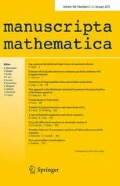Abstract
We consider a real reductive dual pair (G′, G) of type I, with rank \({({\rm G}^{\prime}) \leq {\rm rank(G)}}\). Given a nilpotent coadjoint orbit \({\mathcal{O}^{\prime} \subseteq \mathfrak{g}^{{\prime}{*}}}\), let \({\mathcal{O}^{\prime}_\mathbb{C} \subseteq \mathfrak{g}^{{\prime}{*}}_\mathbb{C}}\) denote the complex orbit containing \({\mathcal{O}^{\prime}}\). Under some condition on the partition λ′ parametrizing \({\mathcal{O}^{\prime}}\), we prove that, if λ is the partition obtained from λ by adding a column on the very left, and \({\mathcal{O}}\) is the nilpotent coadjoint orbit parametrized by λ, then \({\mathcal{O}_\mathbb{C}= \tau (\tau^{\prime -1}(\mathcal{O}_\mathbb{C}^{\prime}))}\), where \({\tau, \tau^{\prime}}\) are the moment maps. Moreover, if \({chc(\hat\mu_{\mathcal{O}^{\prime}}) \neq 0}\), where chc is the infinitesimal version of the Cauchy-Harish-Chandra integral, then the Weyl group representation attached by Wallach to \({\mu_{\mathcal{O}^{\prime}}}\) with corresponds to \({\mathcal{O}_\mathbb{C}}\) via the Springer correspondence.
Similar content being viewed by others
References
Aubert, A.-M., Kraśkiewicz, W., Przebinda, T.: Howe correspondence and Springer correspondence for real reductive dual pairs. Preprint (2012)
Barbasch D., Vogan D.: The local structure of characters. J. Funct. Anal. 37, 27–55 (1980)
Bernon F., Przebinda T.: Boundedness of the Cauchy Harish-Chandra integral. J. Lie Theory 11, 499–613 (2011)
Bernon F., Przebinda T.: Normalization of the Cauchy Harish-Chandra integral. J. Lie Theory 11, 615–702 (2011)
Bernon, F., Przebinda, T.: The Cauchy Harish-Chandra integral and the invariant eigendistributions, Inter. Math. Res. Not. (accepted)
Borho W., Brylinsky J.L.: Differential operators on homogeneous spaces. III. Invent. Math. 80, 1–68 (1985)
Bouaziz A.: Intégrales orbitales sur les algèbres de Lie réductives. Invent. Math. 115, 163–207 (1994)
Carter, R.W.: Finite groups of Lie type. Conjugacy classes and complex characters. Wiley Classics Library, Hoboken (1993)
Collingwood, D., McGovern, W.: Nilpotent orbits in complex semisimple Lie algebras. Reinhold, Van Nostrand, New York (1993)
Daszkiewicz A., Kraśkiewicz W., Przebinda T.: Nilpotent orbits and complex dual pairs. J. Algebra 190, 518–539 (1997)
Geck, M., Pfeiffer, G.: Characters of Finite Coxeter Groups and Iwahori-Hecke Algebras. Clarendon Press, Oxford (2000)
Harish-Chandra: Representations of semisimple Lie groups III. Characters. Proc. Natl. Acad. Sci. 37, 366–369 (1951)
Harish-Chandra: The characters of semisimple Lie groups. Trans. Am. Math. Soc. 83, 98–163 (1956)
Harish-Chandra: Differential operators on a semisimple Lie algebra. Am. J. Math 79, 87–120 (1957)
Harish-Chandra, M.: Invariant eigendistributions on a semisimple Lie algebra. Publ. Math. I.H.E.S. 27, 5–54 (1965)
He, H.; Unipotent representations and quantum induction. Preprint (2007)
Helgason, S.: Groups and geometric analysis, integral geometry, invariant differential operators, and spherical functions. Academic Press, San Diego (1984)
Hotta R., Kashiwara M.: The invariant holonomic system on a semisimple Lie algebra. Invent. Math. 75, 327–358 (1984)
Howe, R.: θ-series and invariant theory. Automorphic forms, representations and L-functions (Proc. Sympos. Pure Math., Oregon State Univ., Corvallis, Ore., 1977). Part 1. In: Proceedings of Symposia in Pure Mathematics, vol. XXXIII, pp. 275–285. Amer. Math. Soc., Providence (1979)
Howe, R.: Wave front sets of representations of Lie groups. In: Automorphic forms, Representation Theory and Arithmetic, pp. 117–140, Tata Institute of Fundamental Research, Bombay (1981)
Howe R.: Transcending classical invariant theory. J. Am. Math. Soc 2, 535–552 (1989)
James, G.D.: Representation theory of the symmetric group. In: Lecture notes in mathematics, vol. 682. Springer, Berlin (1977)
Kazhdan D., Lusztig G.: A topological approach to Springer’s representations. Adv. Math. 38, 222–228 (1980)
Levasseur T., Stafford J.T.: Invariant differential operators and an homomorphism of Harish-Chandra. J. Am. Math. Soc. 8, 365–372 (1995)
Levasseur T., Stafford J.T.: The kernel of an homomorphism of Harish-Chandra. Ann. Sci. Éc. Norm. Sup 4, 385–397 (1996)
Lusztig G.: Irreducible representations of finite classical groups. Invent. Math. 43, 125–176 (1977)
Przebinda T.: Characters, dual pairs, and unitary representations. Duke Math. J. 69, 547–592 (1993)
Przebinda T.: The duality correspondence of infinitesimal characters. Coll. Math. 70, 93–102 (1996)
Przebinda T.: A Cauchy Harish-Chandra Integral, for a real reductive dual pair. Inven. Math. 141, 299–363 (2000)
Przebinda, T.: A Capelli Harish-Chandra Homomorphism. Trans. Am. Math. Soc. 356, 1121–1154 (2004)
Przebinda T.: Local geometry of orbits for an ordinary classical Lie supergroup. Cent. Eur. J. Math. 4, 449–506 (2006)
Ranga Rao R.: Orbital integrals in reductive groups. Ann. Math. 96, 505–510 (1972)
Rossmann, W.: Invariant eigendistributions on a semisimple Lie algebra and homology classes on the conormal variety I: an integral formula; II: representations of Weyl groups, J. Fun. Anal. 96, 130–154, 155–192 (1991)
Rossmann W.: Picard-Lefschetz theory and characters of semisimple a Lie group. Invent. Math. 121, 579–611 (1995)
Schmid, W.: On the characters of the discrete series. The Hermitian symmetric case. Invent. Math. 30, 47–144 (1975)
Shoji, T.: Green functions of reductive groups over a finite field, Proc. Symp. Pure Math. 47, 289–302 (1987)
Spaltenstein, N.: Classes unipotentes et sous-groupes de Borel. Lect. Not. Math. 946 (1982)
Springer, T.A.: A construction of representations of Weyl groups, Invent. Math. 44, 279–293 (1978)
Varadarajan, V.S.: Harmonic analysis on real reductive groups. Lect. Not. Math. 576 (1977)
Wallach, N.: Real reductive groups II. Academic Press, San Diego (1988)
Wallach N.: Invariant differential operators on a reductive Lie algebra and Weyl group representations. J. Am. Math. Soc. 6, 779–816 (1993)
Author information
Authors and Affiliations
Corresponding author
Rights and permissions
About this article
Cite this article
Aubert, AM., Kraśkiewicz, W. & Przebinda, T. Howe correspondence and Springer correspondence for real reductive dual pairs. manuscripta math. 143, 81–130 (2014). https://doi.org/10.1007/s00229-013-0617-y
Received:
Revised:
Published:
Issue Date:
DOI: https://doi.org/10.1007/s00229-013-0617-y


